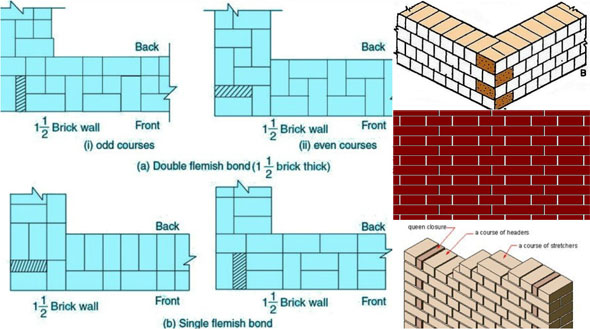
Kinds of Bonds used in Brick Masonry

Bonds are like the arrangement or bricks to strong the imaginable interlocking and stop the flow of the vertical joints that can be done in various ways.
About Bond
Bond is the arrangement of either bricks or stones in every course, so to ensure the greatest imaginable interlocking and to escape the flow of vertical joints in two successive courses; both on the face and in the body of a wall. Generally brick bonds are used in masonry work and these bonds are like patterns in which bricks are laid and it can be applied in both brick walls and paving; besides that it also used to concrete block and other kinds of masonry construction.
Objectives of Bonds
A bond is given to achieve the following objectives-
- The main objective is to provide a bond is to break the flow of the vertical joints in the serial courses both in length and thickness on masonry framework which will act as a bounded mass and its weight will be transformed uniformly to the foundations.
- Secondly it can ensure lengthwise and sidelong strength of the structure.
- It also provides comfortable appearance by laying bricks regularly.
- It can do the masonry stuffs fast by captivating more masons on a job at a time.
Types of Bonds
The types are divided as per laying and bonding style of bricks in walls and the bonds in brick masonry is increased by the mortar filling between layers of bricks and in channels when bricks are laid near to each other and in layers in walls. In brick masonry the most used material is cement mortar; line and mud mortars are also used sometime. Here is the list of the types of bonds which are used in brick masonry:
Stretcher Bond
Header bond
English bond
Flemish bond
it is also known as Dutch bond and is created by laying alternate headers and stretchers in a single course and the next course of brick is laid such that harder lies in the middle of the stretcher in the course below. The thickness is minimum one full brick but the problem of using it is that it need to be aligned vertically for best effects and they are weaker than English bonds for load bearing wall construction.
Facing bond
Dutch bond
English cross bond
Brick on edge bond
Raking bond
Zigzag bond
Garden wall bond
longer narrow faced brick is called as stretcher and this bond is known also as running bond which is created in the time when the bricks are laid with only their stretches, overlapping midway with the courses of bricks below and above. They come with the simplest repeating pattern but the limitation can?t make effective bonding with near bricks in full width thick brick walls. These bonds are generally used in the steel or reinforced concrete framed structures as outer facing and in cavity walls, boundary walls, gardens etc. Walls built with stretcher bonds are not enough strong to stand alone in longer span and height and need supporting structure like brick masonry columns at normal intervals.
Header is the shorter square face of the brick measuring 9cm * 9cm and the header bond is known as heading bond where all the bricks in every course are placed as headers on the faces of the walls. This bond is used for the construction of walls with full brick thickness measuring 18cm and the overlap is similar to half width of the brick.
It has only one course of stretcher and a course of header above it where headers are laid centered on the stretches in course below and every alternate row is vertically aligned. Quoin closer is used in the beginning and the end of a wall after first header to break the flow of vertical joints and a quoin close is a brick cut lengthwise into two halves and used at corners in brick walls.
in this bond, the bricks are arranged for thick walls where facing and backing are needed to be constructed with bricks of different thickness and the bond has heading and stretching corners nicely arranged.
it is a change of the old English cross bond and has alternate courses of headers and stretchers; here the bricks are arranged in a form where every stretching course start at the quoin with a three-quarter bat and the alternate stretching courses has headers placed next to the three-quarter brick bat given at the quoin.
it is like English bond and is very strong to bear a good elevation where queen closer are beside the quoin headers.
It is like English bond but the stretcher courses are replaced by laying the brick on the edges and header courses lay on the beds.
The bonding bricks are arranged in any angle which helps to improve the longitudinal strengthens of thick walls made in English bond.
It is like herring bone bond but the difference is that the bricks are laid in a zigzag style that used in brick paved flooring.
it is very much adopted for one brick thick that can act as a garden wall or a boundary wall and for garden wall bond; it is possible to build uniform faces for a wall without much labor or expense and is very strong also.
Source: www.slideshare.net


